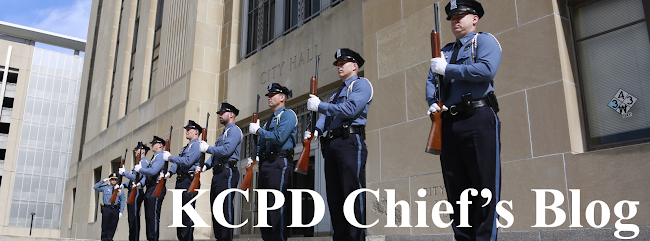The police are just one part of the criminal justice system, and we're happy to be strengthening our relationships with other pieces of that system. Read this story from our July Informant newsletter about the new partnership we're forging with Missouri Probation and Parole to increase public safety:
Kansas City Police and Missouri Probation and Parole are working together more closely than ever and are developing a new initiative to prevent high-risk offenders from committing new crimes.
Shortly after he took office in November 2011, Chief Darryl Forté assigned Sergeant Gary Cooley to get KCPD more involved in the process of offenders re-entering the community after serving prison time. Sergeant Cooley said one thing was glaringly evident from the start.
“There was a big gap between the police department and Probation and Parole,” Sergeant Cooley said. “… They’re eager for a positive, working relationship with police.”
His role has morphed into that of liaison between the police department and Missouri Probation and Parole. Shari Morlang, the Probation and Parole District 4 Administrator, said this is the first time in her 20 years that there has been someone so closely connecting the two agencies.
Cooley said although both organizations have the same goal of public safety, there are several misconceptions police have about Probation and Parole and vice versa. Morlang said having the police liaison position is helping eliminate those.
“One goal of working with Sgt. Cooley is to cross-train and educate each other on our duties and requirements so we have a better understanding,” she said.
This new relationship is leading to a pilot program aimed at increasing public safety: Safety Through Accountability and Community Collaboration, or STACC. Set to launch before the first of September, STACC seeks “to provide intervention, education and accountability to high-risk offenders within the Kansas City, Missouri, Metropolitan area.”
Sergeant Cooley is working with Probation and Parole staff to identify offenders who are most likely to recommit violent crimes upon their release from prison. He, Probation and Parole staff and other police officers will then closely monitor those offenders upon their release into the community. STACC will assist with job and life skills training, housing and other resources to assist the offender with re-integrating into the community.
“This is not a ‘hug-a-thug’ program,” Cooley said. “… STACC will support them if they want to change. If not, we will intervene as quickly as possible before they commit another crime.”
Cooley said offenders identified to be part of STACC will meet with police and Probation and Parole as soon as they are released from prison, followed by several in-home visits.
“It’s puts another layer of accountability in their minds to know that not just Probation and Parole, but also police, are keeping an eye on them,” he said.
Morlang said she is eager to see what STACC can accomplish.
“This is a great opportunity for the agencies to work together to help participants move toward living a more productive, crime-free and fulfilling life while strengthening families and neighborhoods at the same time,” she said. “This really is a win-win for everyone, and I am excited to be part of it.”
Through STACC and his other work, Sergeant Cooley anticipates greater communication between Probation and Parole and police. One of his goals is to notify patrol officers when an offender is released from prison or put on probation in the area they serve.
“I never got that kind of information when I was in the field, and I would have really appreciated it,” he said.
Send comments to kcpdchiefblog@kcpd.org
